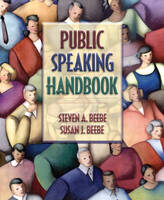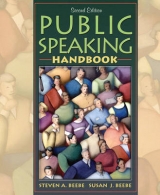
Public Speaking Handbook (Book Alone)
Pearson (Verlag)
978-0-205-42059-9 (ISBN)
- Titel erscheint in neuer Auflage
- Artikel merken
I. INTRODUCTION.
1. Introduction to Public Speaking.
Why Study Public Speaking?
Public Speaking and Conversation.
The Communication Process.
The Rich Heritage of Public Speaking.
Public Speaking and Diversity.
2. Overview of the Speechmaking Process.
Improving Your Confidence as a Speaker.
Nervousness.
Preparing Your First Speech: An Overview of the Speechmaking Process.
3. Ethics and Free Speech.
Speaking Freely.
Speaking Ethically.
Listening Ethically.
II. ANALYZING AN AUDIENCE.
4. Listening.
Barriers to Effective Listening.
Becoming a Better Listener.
Improving Your Note-taking Skills.
Listening and Critical Thinking.
Analyzing and Evaluating Speeches.
Giving Feedback to Yourself.
5. Analyzing Your Audience.
Becoming an Audience Centered Speaker.
Analyzing Your Audience Before You Speak.
Adapting to Your Audience as You Speak.
Analyzing Your Audience After You Speak.
III. PREPARING A SPEECH.
6. Developing Your Speech.
Select and Narrow Your Topic.
Determine Your Purpose.
Develop Your Central Idea.
Generate and Preview Your Main Ideas.
7. Gathering Supporting Materials.
Personal Knowledge and Experience.
The Internet.
Library Resources.
Interviews.
Conducting the Interview.
Following Up the Interview.
Resources from Special-Interest Groups and Organizations.
Research Strategies.
Consider the Potential Usefulness of Resources.
Take Notes.
Identify Possible Presentation Aids.
8. Supporting Your Speech.
Illustrations.
Descriptions and Explanations.
Definitions.
Analogies.
Statistics.
Opinions.
Selecting the Best Supporting Material.
IV. WRITING A SPEECH.
9. Organizing Your Speech.
Organizing Your Main Ideas.
Subdividing Your Main Ideas.
Integrating Your Supporting Material.
Organizing Your Supporting Material.
Developing Signposts.
Supplementing Signposts with Presentation Aids.
10. Introducing Your Speech.
Purposes of Introductions.
Effective Introductions.
11. Concluding Your Speech.
Purposes of Conclusions.
Effective Conclusions.
Inspirational Appeals or Challenges.
12. Outlining Your Speech.
Preparation Outline.
Delivery Outline.
13. Using Words Well: Speaker and Language Style.
Oral Versus Written Language Style.
Using Words Effectively.
Adapting Your Language Style to Diverse Listeners.
Crafting Memorable Word Structures.
Creating Drama.
Tips for Using Language Effectively.
V. DELIVERING A SPEECH.
14. Delivering Your Speech.
The Power of Speech Delivery.
Methods of Delivery.
Characteristics of Effective Delivery.
Audience Diversity and Delivery.
Rehearsing Your Speech: Some Final Tips.
Delivering Your Speech.
Adapting Your Speech Delivery for Television.
15. Speaking in Small Groups.
Solving Problems in Groups and Teams.
Tips for Participating in Small Groups.
Using the Power of Technology in Small Groups.
Leadership in Small Groups.
Managing Meetings.
Presenting Group Recommendations.
Tips for Planning a Group Presentation.
Tips for Making a Group Presentation.
VI. PRESENTATION AIDS.
16. Using Presentation Aids.
The Value of Presentation Aids.
Types of Presentation Aids.
Guidelines for Using Presentation Aids.
17. Designing Presentation Aids.
Guidelines for Developing Presentation Aids.
Guidelines for Designing Visual Aids (Pick up from Cavanaugh, pp. 4-15).
18. Using Presentation Software (Pick up from Cavanaugh, pp. 18-25).
Using PowerPoint and Other Graphic Programs.
Presenting Your Slideshow.
VII. TYPES OF SPEECHES.
19. Speaking to Inform.
Goals of Informative Speaking.
Types of Informative Speeches.
Strategies to Enhance Audience Understanding.
Strategies to Enhance Audience Interest.
Strategies to Enhance Audience Recall.
20. Understanding the Principles of Persuasive Speaking.
Persuasion Defined.
How to Motivate Listeners.
How to Develop Your Persuasive Speech.
Putting Persuasive Principles into Practice.
21. Using Persuasive Strategies.
Establishing Credibility.
Enhancing Your Credibility.
Using Logic and Evidence to Persuade.
Using Emotion to Persuade.
Strategies for Adapting Ideas to People and People to Ideas.
Strategies for Organizing Persuasive Messages.
22. Special Occasion Speaking.
Public Speaking in the Workplace.
Ceremonial Speaking.
After Dinner Speaking.
VIII. APPENDICES.
A. Suggested Speech Topics.
B. Speeches for Analysis and Discussion.
C. Internet Resources.
D. Glossary.
| Erscheint lt. Verlag | 4.8.2004 |
|---|---|
| Sprache | englisch |
| Maße | 191 x 232 mm |
| Gewicht | 989 g |
| Themenwelt | Sachbuch/Ratgeber ► Beruf / Finanzen / Recht / Wirtschaft ► Briefe / Präsentation / Rhetorik |
| ISBN-10 | 0-205-42059-1 / 0205420591 |
| ISBN-13 | 978-0-205-42059-9 / 9780205420599 |
| Zustand | Neuware |
| Informationen gemäß Produktsicherheitsverordnung (GPSR) | |
| Haben Sie eine Frage zum Produkt? |
aus dem Bereich



